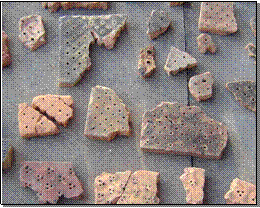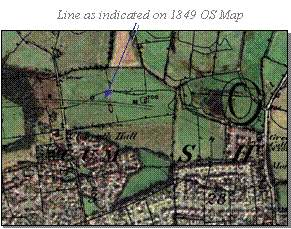Norton Priory has been
selected as one of the finalists for one of the UK’s most prestigious museum awards,
the Gulbenkian Prize. The Runcorn based museum has polled the highest number of hits on
the Gulbenkian website beating both London's National Gallery and the National Trust. For
many years the Priory has encouraged members of the public to become involved in a wide
range of archaeological investigations. In its latest project a medieval herb garden has
been recreated with help from the a local centre for adults with learning difficulties.Summer
Trip
At the beginning of the year we mentioned that our summer trip this year would be to
the Thornborough Henges in North Yorkshire. Unfortunately, this visit is unlikely
to proceed as concerns about site access have been raised. These henges are on private land
and have attracted a great deal of attention due to the present preservation campaign and
so the landowner has become less inclined to allow visitors. This does not mean, however,
that we won’t be having a trip this summer. As I
 mentioned in February’s newsletter, the
Snowdonia National Park Study Centre are very interested in our collection of handmade
kiln tiles, retrieved from our
Standish Hall Corn Mill excavations. Having sent them more
pictures they suspect that we may have the largest group of these early tiles in the
country; with over 50 specimens and at least 10 different styles. They have expressed a
strong interest in seeing them first-hand and have consequently invited us to visit their
Study Centre near Blaenau Ffestiniog. Peter Crews, their Archaeological Officer, says
there is lots of good archaeology close by for us to see, including pre-historic and
medieval iron-workings. It is a bit of a journey down there but sounds like it could be
well worthwhile (something to discuss at the next meeting). mentioned in February’s newsletter, the
Snowdonia National Park Study Centre are very interested in our collection of handmade
kiln tiles, retrieved from our
Standish Hall Corn Mill excavations. Having sent them more
pictures they suspect that we may have the largest group of these early tiles in the
country; with over 50 specimens and at least 10 different styles. They have expressed a
strong interest in seeing them first-hand and have consequently invited us to visit their
Study Centre near Blaenau Ffestiniog. Peter Crews, their Archaeological Officer, says
there is lots of good archaeology close by for us to see, including pre-historic and
medieval iron-workings. It is a bit of a journey down there but sounds like it could be
well worthwhile (something to discuss at the next meeting).
Roman Road Update
We haven’t yet arranged a field trip to the sites mentioned in last month’s
newsletter. This we hope to do in the not to distant future, but in the meantime Mark
Heyward took me out last weekend to have a quick reconnoitre of these promising sites.
Miller’s Lane
The line as shown on the 1849 OS map does not cross Miller’s lane at the point
where Mark spotted the bank in the field and hump in the road. This may be the
map-maker’s error as nothing is visible at the point suggested on the map. At both
positions however there is plenty of scope for investigation with our resistivity meter. A
quick word with the landowner has secured access for a survey and after Easter we will
arrange a field trip.
Shakerley
This site is very disappointing, despite a good description by the 19th century
antiquarian Sibson (see last month’s newsletter). To the east of the lane leading to
Cleworth Hall, there is a huge landscaped dirt-rook which has completely covered anything
associated with the original fields surface (it just shows how aerial photos can be
misleading). On the west side of the lane, well cultivated allotments hide any sign of the
ancient route. Chatting with the corresponding allotment holders it quickly became clear
that nothing had emerged during their cultivations to indicate the existence of an ancient
highway.
Cleworth Hall
The huge spoil tip to the east stretches all the way to lane at Cleworth Hall
completely covering anything that may have survived. To the east, however, of this lane
the fields look untouched. The road here is marked quite strongly on the 1849 OS map and
is even marked as a R O M A N R O A D . There are no obvious signs in the field to suggest
a buried road, however a scan with the meter may show something.

Next Meeting (WAS)
Wednesday 7th April at the BP Centre (Scout HQ) in Greenough Street,
at 7.30 pm as usual. This month’s speaker is our friend Jack Smith
from Chorley Archaeological Society who will be giving a talk on Birkacre;
an area just to the south of Chorley which has seen its fair share of industrial activity
over the centuries and was at the heart of the industrial revolution. A talk not to be
missed. B.A.
|



